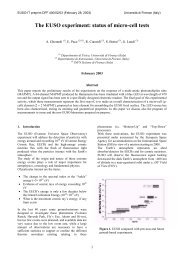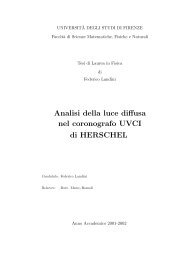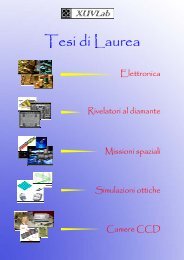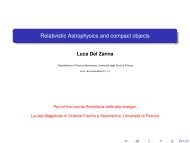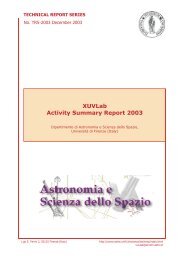Diamond-based UV and soft X-ray photodetectors E. Pace Dip. di ...
Diamond-based UV and soft X-ray photodetectors E. Pace Dip. di ...
Diamond-based UV and soft X-ray photodetectors E. Pace Dip. di ...
Create successful ePaper yourself
Turn your PDF publications into a flip-book with our unique Google optimized e-Paper software.
Figure captionsFigure 1 Absorption spectrum of CVD<strong>di</strong>amond in the deep <strong>UV</strong> up in energies to the<strong>soft</strong> X-<strong>ray</strong> region (data from ref. [2]).Figure 2 Reflectance of a single crystal natural<strong>di</strong>amond (data from ref. [16]).Figure 3 Micro-Raman spectrum of a nontexturedCVD <strong>di</strong>amond film obtaine<strong>di</strong>lluminating a single grain at wavelength 514.5nm. The inset shows the linewidth of the<strong>di</strong>amond line (ref.[40]).Figure 4 Photocurrent versus the electric fieldfor a <strong>di</strong>amond-<strong>based</strong> photoconductor. The samebehaviour has been reported for two <strong>di</strong>fferentwavengths. At high electric field thephotocurrent saturates, since photogeneratedcharge is fully collected.Figure 5 X-Ray Diffraction patterns for 4<strong>di</strong>fferent CVD <strong>di</strong>amond films, described in theTable 1. Table 1 explains also the meaning ofthe parameter p.Figure 6 Skecth of a typical <strong>di</strong>amondphotoconductor.Figure 7 SEM image of inter<strong>di</strong>gitated Agcontacts on a textured <strong>di</strong>amond film. The<strong>di</strong>stance between two metal strips is 12.5 µm.Figure 8 Schematic of the experimentalapparatus used for measurements in the vacuum<strong>UV</strong> (λ < 200 nm).Figure 9 Dark currents measured for <strong>di</strong>amondfilms having Ag ohmic contact (a,b), Au (c)<strong>and</strong> Ti-Au (d) rectifying contacts. Dark currentsin (a) <strong>and</strong> (b) are reported for planar <strong>and</strong>s<strong>and</strong>wich devices <strong>and</strong> they can be compared tothe same measurements performed in air.Figure 10 Quantum efficiency for a singlecrystal natural <strong>di</strong>amond (a) <strong>and</strong> a CVD-grownpolycrystalline <strong>di</strong>amond film (b) (data fromrefs. [3,32])Figure 11 Spectrum of a D 2 lamp in the 120-300 nm wavelength region (b,c,d) as detectedby three <strong>di</strong>amond <strong>photodetectors</strong> having planarelectric contacts. The same spectrum (a),recorded by an <strong>UV</strong> sensitive phosphor coatedphotomultiplier, has been reported forcomparison.Figure 12 Relative quantum efficiency of three<strong>di</strong>amond detectors with respect to thephotomultiplier. Quantum efficiency curve fora s<strong>and</strong>wich <strong>di</strong>amond device has been reportedfor comparison.Figure 13 Normalized responsivity of some<strong>di</strong>amond-<strong>based</strong> detectors: a microwave plasmaCVD-grown sample (i), a hot filament CVDgrownfilm (ii) <strong>and</strong> another microwave plasmaCVD-grown sample but nitrogen doped (iii).The curve (iv) is relative to sample (ii) after along <strong>UV</strong> exposure (data from ref. [32]).Figure 14 Comparison among photocurrentsproduced by several microwave plasma CVDgrownfilms. The preferential orientation hasbeen in<strong>di</strong>cated to show the correlation betweenthe photocurrent <strong>and</strong> the film texture both inplanar <strong>and</strong> s<strong>and</strong>wich configurations.Figure 15 Plot showing the correlationbetween the photocurrent <strong>and</strong> the preferentialorientation of crystals in the <strong>di</strong>amond films(parameter p).Figure 16 Temporal behaviour ofphotocurrent.



